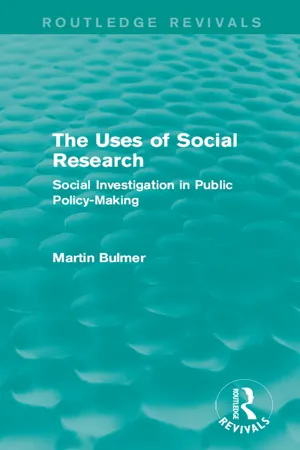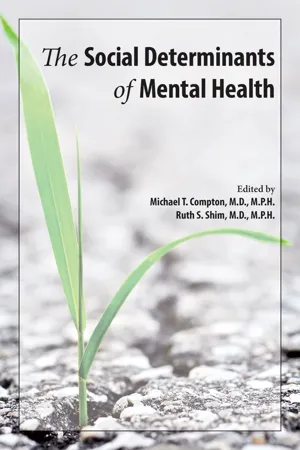Psychology
Sykes Deprivation Model
The Sykes Deprivation Model is a psychological theory that suggests that individuals who experience a sudden loss of freedom or autonomy may become more likely to engage in criminal behavior. This model emphasizes the importance of social and environmental factors in shaping criminal behavior, rather than solely focusing on individual characteristics.
Written by Perlego with AI-assistance
Related key terms
4 Key excerpts on "Sykes Deprivation Model"
- eBook - ePub
The Uses of Social Research (Routledge Revivals)
Social Investigation in Public Policy-Making
- Martin Bulmer(Author)
- 2015(Publication Date)
- Routledge(Publisher)
An interesting case of the complexity of research is provided by the concept of ‘deprivation’. This has a central place in the study of social policy, where it has developed out of the study of more specific social problems such as poverty, malnutrition, ill-health, bad housing conditions, and so on. Defining some of these specific concepts can be problematical; the concept of the poverty line, for example, is not simple and straightforward. But ‘deprivation’ is at a higher level of generality and relates to a broad range of concerns within social policy and social work studies.Deprivation may be defined as a state of mind in which an individual or set of individuals is without something which one believes they should not be without. What is it, however, that they are without? Is it material resources, or access to services, or affection and psychological support, or what? Different disciplines give different answers to the question. The study of maternal deprivation (see Bowlby, 1951; Ainsworth, 1962) is concerned with the consequences of lack of maternal love. Adequate mothering implies a loving relationship between mother and baby, which leads to an attachment which is unbroken, which provides adequate stimulation, in which the mothering is provided by one person, and which occurs in the child’s own family. The absence of one or more of these characteristics is said to constitute maternal deprivation, with harmful consequences for the child. For example, a child’s ability to form deep interpersonal relationships in adulthood may be based in part on having formed satisfactory bonds with other people in the first three years of life. Other psychologists, however, have preferred to use deprivation to refer to lack of sensory stimulation alone, as being more specific and measurable (Casler, 1961). Runciman’s (1966) sociological approach, on the other hand, treats deprivation as a lack of financial and material resources, without any reference to lack of psychological stimulus. Yet other approaches treat deprivation as synonymous with psycho-social disadvantage (Eckland and Kent, 1968).It is hardly news that different disciplines define the concept in different ways. Yet this cannot be ignored in the study of social policy, for the researcher must define his terms and justify the definition selected. How is a choice made between the different competing definitions? Perhaps more difficult still is the fact that the concept is not even used consistently within a single framework, reflecting the woolliness and lack of precision of many social science concepts. Maternal deprivation, for example, has been used to cover ‘every undesirable interaction between mother and child – rejection, hostility, cruelty, over-indulgence, repressive control, lack of affection and the like’ (Ainsworth, 1962). A review by Michael Rutter of research in the field concludes that: - eBook - ePub
- Colin Jones(Author)
- 2017(Publication Date)
- Routledge(Publisher)
While the methodological difficulties of the empirical studies have been discussed briefly what these studies also illustrate are the problems of the initial conceptualisation of the problem itself. The definitional framework outlined inhibits critical analysis in two ways: it focuses on consequences not causes and thinks in terms of individuals not structures. These two deficiencies are intimately related to each other. Deprivation has been seen as a state or position occupied by particular individuals. Analysis in these terms tends to produce counts of different types of individuals, different minority groups, seen as separated subsets each of which faces a particular difficulty (e.g. unemployment, old age, low pay) for which as we have noted, there are appropriate established policy frameworks. An alternative logic to the problem of definition illustrates the extent to which this framework restricts analysis and forecloses discussion of certain key issues. This alternative approach starts by noting that the word deprivation comes from an active verb, to deprive. Deprivation should be seen therefore as a process whereby groups or individuals are deprived. Immediately we are focusing on the systematic mechanisms whereby a process of deprivation occurs. The incidence and nature of particular deprived groups are the end result of this process. This approach does not exclude the possibility that one element within this process is the position, attributes and behaviour of the deprived themselves, but it does emphasise that these characteristics of the deprived are only relevant in the context of a more general process. The mechanisms which are relevant here are clearly not the unique and idiosyncratic biographies or circumstances of particular individuals but the regularised, indeed routinised, series of events and practices which reproduce deprivation - eBook - ePub
- Michael T. Compton, Ruth S. Shim(Authors)
- 2015(Publication Date)
- American Psychiatric Association Publishing(Publisher)
Third, because of entrenched bureaucracy and programmatic barriers such as rigid means testing or punitive sanctions, many programs can be either inaccessible or even harmful to those most in need of help. Finally, the experience of chronic poverty and neighborhoodlevel 137 deprivation may cause so much stress in certain individuals and communities that it leads to a decreased ability or willingness to make use of available resources as a result of a deep-seated combination of distrust, exhaustion, and hopelessness that renders people less able to take advantage of well-meaning efforts to help. In a way, this perspective can be viewed as an understandable technique for coping with chronic stress and deprivation and may partially explain the perplexing interplay between social causation and social selection identified in some research. What can individual clinicians do in the face of such seemingly insurmountable barriers? The answer lies outside of clinics, hospitals, and traditional roles as health care providers treating patients and instead is found in communities, society as a whole, and roles as citizens advocating for policy and social change. Policy Approaches to Inequality, Poverty, and Neighborhood Deprivation as Social Determinants of Mental Health Referring again to Figure 6–1, it is clear that the most comprehensive approach to addressing the economic social determinants of mental health is to intervene on the multiple levels on which inequality and poverty have been shown to affect mental health outcomes - eBook - ePub
Homelessness
Research, Practice, and Policy
- S. P. K. Jena(Author)
- 2020(Publication Date)
- Routledge India(Publisher)
5 Deprivation and human developmentIntroduction
Deprivation (poverty) has been examined from multiple angles. It is characterized by an individual’s inability to meet the required material minimum and a state of pronounced deprivation of well-being (Millennium Ecosystem Assessment, 2003), in which income is insufficient to provide the necessities of life such as food, shelter, clothing, and medical care. This is often calculated by taking reference of the minimum income level of people living in the country of reference. In this context, a homeless person may experience deprivation of virtually anything that an individual needs to survive. Hunger or malnutrition, loss of opportunity for education, unhygienic conditions of living, disease, and poor behavioural skills are only the principal indices of this state of deprivation. Overcoming this state of deprivation becomes the prime preoccupation and object of cathexis. It prevents normal mental and affective investment in different aspects of daily life, which is often observed in the deprived individual’s general loss of ‘motivation for growth’. Thus, the consequences of deprivation or ‘object loss’ are far-reaching and psychologically crippling. This is much more extensive than loss of a single ‘love object’ in one’s life. It affects a wide range of actions, feelings, and emotions.Deprivation as ‘object loss’
This pathological state of mind created by deprivation or ‘object loss ‘has varied manifestations, which require empathic consideration. Apart from material support, the role of the people in general and a caregiver or psychotherapist in particular is important. They could help in redirecting them and thereby balancing out, focusing on object relation in other spheres of life. The primary purpose of such a therapeutic relationship is nurturing and maintaining a stable object relation by creating stable ‘representations’ in the mind. This may be in the form of images, and symbols that are substituted for the original objects of love. Substitutions occur naturally when a love object is lost, no matter whether it is a ‘good’ or ‘bad’ object. ‘Good’ objects are those which maximally satisfy certain human needs and ‘bad’ objects are those which frustrate most by depriving the individual and both of them, cause stable representations. These substitutions are constituted of constellation of emotions, thoughts, and action tendencies. Both the extreme object relations disrupt normal behavioural processes are never complete. The intensity of ‘fixations’ determines the extent of it impact on the behaviour. Developing stable object relation through trusting therapeutic relationship influence the individual’s interpretations and understanding of the immediate experiences of everyday life.
Index pages curate the most relevant extracts from our library of academic textbooks. They’ve been created using an in-house natural language model (NLM), each adding context and meaning to key research topics.



